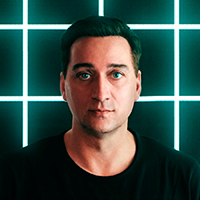
Paul van Dyk (real name — Matthias Paul) is a German DJ, producer, and composer — one of the pioneers of trance music and a key figure in the history of the global electronic scene. Born on December 16, 1971 in Eisenhüttenstadt (East Germany), Paul has remained for over three decades a symbol of pure, emotional, and inspiring trance sound — a genre he helped shape and popularize around the world.
Early years and musical roots
Paul’s childhood took place in East Germany — a country where Western music was forbidden. His first exposure to Western culture came through pirate radio and illegal recordings broadcast from West Berlin. Inspired by synth-pop and the electronic scene of the 1980s (Depeche Mode, Kraftwerk, New Order), he developed an early fascination with synthesizers and studio production.
After the fall of the Berlin Wall in 1989, young Paul moved to a reunified Berlin — the epicenter of new freedom, where techno and rave culture were emerging. This was where his professional journey as a DJ and producer began.
Career beginnings: Tresor and E-Werk
In the early 1990s, Paul van Dyk began performing in Berlin’s legendary clubs Tresor and E-Werk. The latter became his true home — a place where he developed his unique style blending the energy of house, the depth of techno, and the melodic storytelling that would define trance. His sets were known not just for their rhythm but for their emotional structure — the essence of van Dyk’s future signature.
In 1994, he released his debut album “45 RPM” on the MFS label. The record became a landmark for Germany’s electronic scene, proving that trance could be both danceable and profoundly emotional.
Global recognition and rise to fame
True success came with his second album “Seven Ways” (1996), which received critical acclaim and was named one of the best electronic albums of the decade. Tracks like “Beautiful Place,” “Forbidden Fruit,” and “Words” became anthems of the 1990s rave generation.
In 1998, Paul’s remix of the iconic Binary Finary — “1998” became the manifesto of the trance renaissance and brought him international fame. In 2000, he released his masterpiece — the album “Out There and Back”, featuring the immortal hit “For An Angel”, one of the most recognizable trance tracks in history — a festival anthem and symbol of the entire electronic era.
The 2000s: global tours and innovation
In 2003, Paul released “Reflections” — the first DJ album ever nominated for a Grammy in the category “Best Electronic/Dance Album.” It featured hits like “Nothing But You” and “Time of Our Lives” (with Vega 4), showcasing a mature, cinematic approach to production.
In 2005 and 2006, Paul van Dyk was voted #1 in the DJ Mag Top 100 DJs. He became the first German to earn the title — and one of the few artists to remain in the top ranks for more than 20 consecutive years.
During this period, he toured the globe — from Ibiza and Miami to Tokyo and Cape Town — and released “In Between” (2007), blending progressive trance, electro, and breaks, collaborating with Giuseppe Ottaviani, Lo Fi Sugar, and Rea Garvey.
Challenges and comeback
In 2016, while performing at A State of Trance 750 in the Netherlands, Paul suffered severe injuries after a stage fall. After a long recovery, he returned stronger than ever with one of his most emotional albums — “From Then On” (2017). The album symbolized his physical and spiritual rebirth — from silence to new inspiration.
This was followed by “Guiding Light” (2020) and “Off the Record” (2023), reaffirming that trance can still be relevant, human, and alive. He continues to perform at the world’s leading festivals — EDC, Tomorrowland, Creamfields, Ultra Music Festival — and curates the classic Trance Energy lineup.
Musical style and artistry
Paul van Dyk is a composer and an architect of sound. His music is built on three pillars: melody, emotion, and energy. He rejects commercial trends, remaining faithful to the philosophy of “real trance” — music that creates an emotional space where the listener experiences catharsis.
His tracks combine deep synth pads, hypnotic grooves, and uplifting harmonies. He has influenced an entire generation of artists — from Armin van Buuren and Above & Beyond to Aly & Fila and Cosmic Gate. His legacy represents the school of authentic trance — music as a language of the soul, not of industry.
Humanitarian and social work
Paul van Dyk is deeply involved in social and humanitarian causes. He supports initiatives focused on education, poverty reduction, child protection, and cultural development. He has collaborated with organizations such as Rock the Vote, Peace One Day, and the Red Cross, as well as supported UN humanitarian projects.
In the 2020s, he became an active voice for independent artists affected by the pandemic and advocates for the concept of “music as therapy” — using sound to promote healing and emotional balance.
Legacy and influence
Paul van Dyk is one of the most respected figures in the history of electronic music. He was among the founders of global trance culture, shaping the sound of the 1990s and 2000s, and continues to inspire new generations of producers. His music serves as a bridge between eras — from industrial Berlin to the world’s biggest festival stages.
Paul’s music is a journey through time and space, where melody becomes emotion and rhythm becomes life energy. His name is forever tied to timeless tracks like “For An Angel”, “Nothing But You”, “Let Go”, and “Connected”.
Today, more than 30 years into his career, Paul van Dyk continues to tour the world, release new music, and remain true to his creed: “Music is not escapism. It’s a way to make the world a better place.”

![Cover Paul Van Dyk & Troels Hammer - Alternative Sphere [Original Mix] Paul Van Dyk & Troels Hammer - Alternative Sphere [Original Mix]](/images/covers/2025/05/100_13455.jpg)
![Cover Paul Van Dyk & Aly & Fila - Shine Ibiza Anthem 2022 [Original Mix] Paul Van Dyk & Aly & Fila - Shine Ibiza Anthem 2022 [Original Mix]](/images/covers/2025/05/100_13454.jpg)
![Cover Paul Van Dyk & Christian Burns - But Not Tonight [Album Mix] Paul Van Dyk & Christian Burns - But Not Tonight [Album Mix]](/images/covers/2025/05/100_13452.jpg)
![Cover Paul Van Dyk & Fuenka - Artefact [Album Mix] Paul Van Dyk & Fuenka - Artefact [Album Mix]](/images/covers/2025/05/100_13451.jpg)
![Cover Paul Van Dyk, Chris Bekker & Jan Dzialek - Rhapsody [Album Mix] Paul Van Dyk, Chris Bekker & Jan Dzialek - Rhapsody [Album Mix]](/images/covers/2025/05/100_13448.jpg)
![Cover Paul Van Dyk & Alex M.O.R.P.H. - Hawkins Square [Album Mix] Paul Van Dyk & Alex M.O.R.P.H. - Hawkins Square [Album Mix]](/images/covers/2025/05/100_13447.jpg)
![Cover Paul Van Dyk & Weekend Heroes feat. Schottstaedt - Venture X [Original Mix] Paul Van Dyk & Weekend Heroes feat. Schottstaedt - Venture X [Original Mix]](/images/covers/2025/05/100_13444.jpg)

![Cover Paul Van Dyk & Jordan Gill - Voltage [Original Mix] Paul Van Dyk & Jordan Gill - Voltage [Original Mix]](/images/covers/2025/05/100_13442.jpg)
![Cover Paul Van Dyk x Phuture x DJ Pierre - Acid Traxxx [Original Mix] Paul Van Dyk x Phuture x DJ Pierre - Acid Traxxx [Original Mix]](/images/covers/2025/05/100_13440.jpg)
![Cover Paul Van Dyk - Filthy Acid [Original Mix] Paul Van Dyk - Filthy Acid [Original Mix]](/images/covers/2025/05/100_13439.jpg)
![Cover Paul Van Dyk, Saad Ayub & Elevation - Ouverture [Original Mix] Paul Van Dyk, Saad Ayub & Elevation - Ouverture [Original Mix]](/images/covers/2025/05/100_13437.jpg)

![Cover Paul Van Dyk & Christian Schottstaedt - Let Go And Listen [PvD's Fav Timeless Mix] Paul Van Dyk & Christian Schottstaedt - Let Go And Listen [PvD's Fav Timeless Mix]](/images/covers/2025/05/100_13435.jpg)

